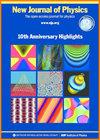用于空间领域感知的自适应量子加速成像技术
IF 2.8
2区 物理与天体物理
Q2 PHYSICS, MULTIDISCIPLINARY
引用次数: 0
摘要
太空活动的增长增加了对太空领域感知(SDA)的需求,以确保安全的太空操作。然而,由于空间目标外观暗淡、角尺寸/间隔小、分布密集以及大气湍流,成像和探测空间目标具有挑战性。这些挑战使得地面成像观测中的太空目标成为亚雷利级的点状物体,具有极强的亮度对比,但光子预算较低。在此,我们建议使用最近开发的量子加速成像(QAI)来应对 SDA 挑战。我们主要关注三个 SDA 挑战(1)最小先验假设(2)多目标问题(3)极端亮度比。我们还介绍了大气湍流情况下的源估计和定位结果。在所有 SDA 挑战中,QAI 对位置、亮度和目标数量的估计都有明显改善。特别是,在亮度比为 1000 倍的恒星等极端情况下,我们的源检测性能比高度优化的直接成像技术高出 2.5 倍。通过 10,000 多次模拟,我们验证了与传统的先进直接成像相比,我们的方法提高了分辨率,为量子光学方法用于 SDA 铺平了道路。本文章由计算机程序翻译,如有差异,请以英文原文为准。
Adaptive quantum accelerated imaging for space domain awareness
The growth in space activity has increased the need for Space Domain Awareness (SDA) to ensure safe space operations. Imaging and detecting space targets is, however, challenging due to their dim appearance, small angular size/separation, dense distribution, and atmospheric turbulence. These challenges render space targets in ground-based imaging observations as point-like objects in the sub-Rayleigh regime, with extreme brightness contrast but a low photon budget. Here, we propose to use the recently developed quantum-accelerated imaging (QAI) for the SDA challenge. We mainly focus on three SDA challenges (1) minimal a priori assumptions (2) many-object problem (3) extreme brightness ratio. We also present results on source estimation and localization in the presence of atmospheric turbulence. QAI shows significantly improved estimation in position, brightness, and number of targets for all SDA challenges. In particular, we demonstrate up to 2.5 times better performance in source detection than highly optimized direct imaging in extreme scenarios like stars with a 1000 times brightness ratio. With over 10 000 simulations, we verify the increased resolution of our approach compared to conventional state-of-the-art direct imaging paving the way towards quantum optics approaches for SDA.
求助全文
通过发布文献求助,成功后即可免费获取论文全文。
去求助
来源期刊

New Journal of Physics
物理-物理:综合
CiteScore
6.20
自引率
3.00%
发文量
504
审稿时长
3.1 months
期刊介绍:
New Journal of Physics publishes across the whole of physics, encompassing pure, applied, theoretical and experimental research, as well as interdisciplinary topics where physics forms the central theme. All content is permanently free to read and the journal is funded by an article publication charge.
 求助内容:
求助内容: 应助结果提醒方式:
应助结果提醒方式:


